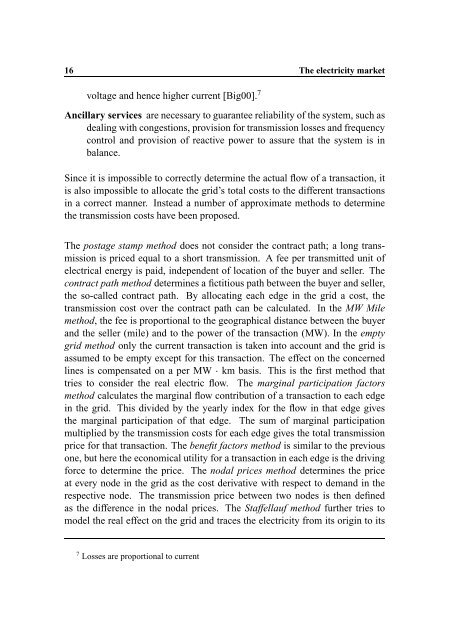Hedging Strategy and Electricity Contract Engineering - IFOR
Hedging Strategy and Electricity Contract Engineering - IFOR
Hedging Strategy and Electricity Contract Engineering - IFOR
Create successful ePaper yourself
Turn your PDF publications into a flip-book with our unique Google optimized e-Paper software.
16 The electricity market<br />
voltage <strong>and</strong> hence higher current [Big00]. 7<br />
Ancillary services are necessary to guarantee reliability of the system, such as<br />
dealing with congestions, provision for transmission losses <strong>and</strong> frequency<br />
control <strong>and</strong> provision of reactive power to assure that the system is in<br />
balance.<br />
Since it is impossible to correctly determine the actual flow of a transaction, it<br />
is also impossible to allocate the grid’s total costs to the different transactions<br />
in a correct manner. Instead a number of approximate methods to determine<br />
the transmission costs have been proposed.<br />
The postage stamp method does not consider the contract path; a long transmission<br />
is priced equal to a short transmission. A fee per transmitted unit of<br />
electrical energy is paid, independent of location of the buyer <strong>and</strong> seller. The<br />
contract path method determines a fictitious path between the buyer <strong>and</strong> seller,<br />
the so-called contract path. By allocating each edge in the grid a cost, the<br />
transmission cost over the contract path can be calculated. In the MW Mile<br />
method, the fee is proportional to the geographical distance between the buyer<br />
<strong>and</strong> the seller (mile) <strong>and</strong> to the power of the transaction (MW). In the empty<br />
grid method only the current transaction is taken into account <strong>and</strong> the grid is<br />
assumed to be empty except for this transaction. The effect on the concerned<br />
lines is compensated on a per MW km basis. This is the first method that<br />
tries to consider the real electric flow. The marginal participation factors<br />
method calculates the marginal flow contribution of a transaction to each edge<br />
in the grid. This divided by the yearly index for the flow in that edge gives<br />
the marginal participation of that edge. The sum of marginal participation<br />
multiplied by the transmission costs for each edge gives the total transmission<br />
price for that transaction. The benefit factors method is similar to the previous<br />
one, but here the economical utility for a transaction in each edge is the driving<br />
force to determine the price. The nodal prices method determines the price<br />
at every node in the grid as the cost derivative with respect to dem<strong>and</strong> in the<br />
respective node. The transmission price between two nodes is then defined<br />
as the difference in the nodal prices. The Staffellauf method further tries to<br />
model the real effect on the grid <strong>and</strong> traces the electricity from its origin to its<br />
7 Losses are proportional to current
















